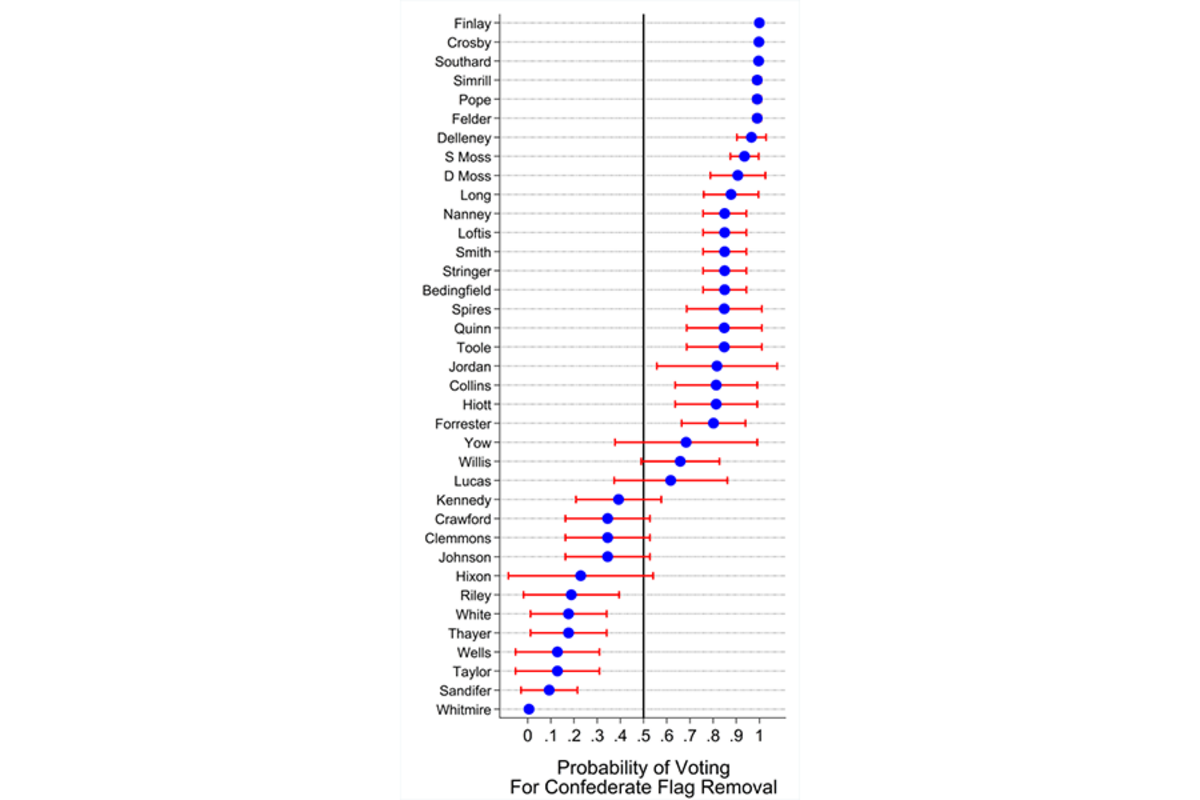South Carolina: Why vote to remove Confederate flag is no sure thing
Loading...
Do opponents of the Confederate flag have the votes to remove it from South Carolina’s Capitol grounds?
In an attempt at answering this question, Charleston’s newspaper, , did the yeoman’s work of contacting all 170 state lawmakers and . It’s an important bit of journalism, one that informs citizens and holds lawmakers accountable, and has from a number of .
As of Thursday at 5:00 p.m., the Senate looks certain to vote to take down the Confederate flag. At the time of this post, 33 senators have expressed their support for removing the flag while only 2 stand in opposition. With just 46 members, this clears the requisite two-thirds majority needed to secure passage.
However, the House is short of the necessary votes. While it seems like a safe bet that the lower chamber will eventually cross the two-thirds threshold, there are reasons to be cautious. Indeed, The Post & Courier’s data suffer from a problem known as “non-response bias.” In this case, the data almost certainly overstate support for bringing down the flag.
At the present time, nearly 90% of representatives support taking down the flag. However, among those that haven’t responded, 100 percent (all of them) are Republicans – and many are from very conservative districts.
Simply put, if a large enough bloc of these “non-respondents” are secretly “no” votes, the effort to take down the Confederate flag could be in jeopardy. Looking at the breakdown of these lawmakers, it’s apparent that some (perhaps most) of the non-respondents are hiding their opinion by not answering. It’s a classic – yet frustrating – problem in survey research.
Fortunately, common statistical models can help us “fix” this problem and simulate the final vote total (but see some important caveats below). In this analysis, The Post and Courier’s data serves as the dependent variable (using a lawmaker’s “yes,” “no,” and “missing” responses). Independent variables include a lawmaker’s party affiliation as well as demographic data from the counties in their legislative district: (1) Obama’s vote share in 2012, (2) the percentage of black residents, (3) the percentage with at least high school degree, and (4) the percentage 65-plus age group. (County data is an imperfect proxy for a lawmaker’s constituents because some districts span small parts of a county. However, it’s the only data available. Add this to the list of caveats.)
Without including too many of the boring details, two models are estimated: one predicting why a lawmaker has yet to reveal his or her position (which helps “fix” the non-response bias) and a second predicting a lawmaker’s response. What the model gives us is the predicted probability that the non-respondent will be a “yes” or a “no” vote.
In the figure below, I report the predictions (again, just for those who have yet to reveal their preference). A blue dot signifies the predicted probability of voting for removing the Confederate flag while the red bar represents the prediction’s variability. A larger red bar indicates the model is less certain about how a lawmaker will vote.
Looking at the bottom of the figure, William “Bill” Whitmire (R) is the most likely non-respondent to vote against removing the flag (the model gives him a 2 percent chance of voting for Confederate flag removal). In Oconee County—where his district is located—just 28 percent of voters voted for Obama in 2012. Further, only eight percent are black and Oconee County has the second largest percentage of residents over the age of 65 in South Carolina.
In contrast, at the top of figure, Kirkman Finlay, III (R) is the most likely non-respondent to vote for removing the flag (the model gives him a 99 percent chance). In Richland County, where his district is located, 65 percent of residents voted for Obama in 2012. Richland County also has a high percentage of blacks and residents with at least a high school degree and a low percentage of those over the age of 65.
Most importantly, among the 37 holdouts, only 12 are predicted to vote against removing the Confederate flag from the Capitol grounds. In contrast, 25 are predicted to vote for removing the flag. Note that this is based on assigning those less than 50 percent to the “no” column and those more than 50 percent to the “yes” column. An obvious caveat: There is significant variability in the model; this is not the kind of thing that can be predicted with certainty. For example, while James “Jay” Lucas is currently in the “yes” column (at 61 percent) and Ralph Kennedy, Jr. is in the “no” column (at 40 percent), it wouldn’t be that surprising if either voted the opposite way.
Finally, if we include the declared “yes” and “no” respondents in the tabulation, we get a final vote total of 101-23. Needless to say, this crosses the two-thirds threshold.
A few more caveats. First, my gut feeling is that the model is too bullish on the probabilities of a “yes” vote. While I think the House has the votes to remove the flag, I wouldn’t be surprised if a number of the non-respondents in the “yes” column end up being “no” votes. Second, The Post & Courier’s dataset records support for removing the Confederate Flag in the abstract. At the present time, there are three bills that have been introduced in the General Assembly. Furthermore, the committees receiving referral of the those bills can make their own statutory additions or subtractions. In the end, the nature of the bill could change the predictions dramatically.
But while there are still reasons to be cautious, it seems like a good bet that the Confederate flag is coming down from South Carolina’s Capitol grounds.
Jordan Ragusa publishes his Rule 22 blog at .





